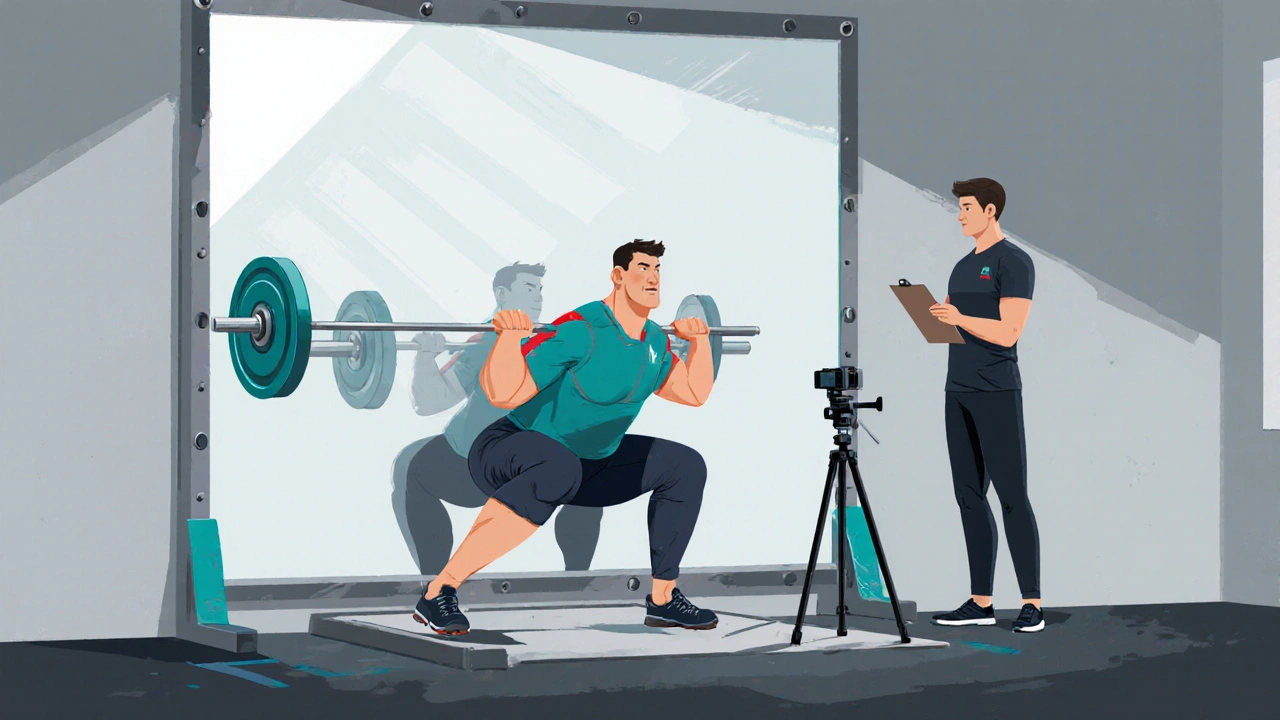
Gym Injury Prevention Checklist
Warm-Up Routine
Adequate warm-up prepares your body for exercise and reduces injury risk.
Form & Technique
Correct form is crucial for preventing common gym injuries.
Equipment Safety
Proper equipment handling prevents accidents and injuries.
Recovery Habits
Recovery supports healing and injury prevention.
Your Injury Prevention Score
Score: 0%
Prevention Tips Based on Your Score
Ever walked out of a training session feeling sore, then realized you actually pushed yourself into an injury? It’s a frustrating reality for many gym‑goers, but most of these setbacks are avoidable. Below you’ll find a practical roadmap that tackles the main culprits behind gym injuries and shows you how to keep your workouts effective and pain‑free.
What counts as a "common gym injury"?
Before you can prevent anything, you need to know what you’re dealing with. In the fitness world, a handful of injuries show up far more often than others. They include muscle strains, joint sprains, lower‑back pain, shoulder impingement, and knee tendinitis. While each has its own quirks, they share a few root causes: poor technique, insufficient warm‑up, over‑loading too quickly, and unsafe equipment handling.
Gym Injuries are a set of musculoskeletal problems that arise during strength, cardio, or flexibility training, typically caused by incorrect form, inadequate preparation, or excessive load. Understanding the anatomy of each injury helps you spot red flags early and apply the right preventative measures.
Key injuries and how they happen
- Muscle Strain - Over‑stretching or tearing a muscle fiber, often from rapid, uncontrolled movements.
- Joint Sprain - Ligament damage caused by sudden twists or impacts, common in Olympic lifts and plyometrics.
- Lower‑Back Pain - Resulting from improper hip hinging, rounded posture, or lifting with a rounded spine.
- Shoulder Impingement - Compression of rotator‑cuff tendons during overhead presses or bench presses.
- Knee Patellar Tendonitis - Overuse of the knee extensor mechanism, often seen in squats and jumping drills.
Three‑step framework for injury‑free training
- Warm‑up intelligently: Move from general cardio to dynamic stretches that mimic the upcoming movement patterns.
- Master the fundamentals: Prioritize correct form using lighter loads before adding weight.
- Use mirrors or ask a trainer for feedback.
- Record a short video of your lift to spot errors.
- Progress gradually: Follow the principle of progressive overload - increase load, volume, or intensity in small, measurable steps (typically 5‑10% per week).
Effective warm‑up routine (7‑minute guide)
Think of a warm‑up as the rehearsal before a performance. It prepares the nervous system, raises muscle temperature, and lubricates joints.
- General cardio (2 minutes) - Light jog, brisk walk, or jump rope to boost heart rate.
- Dynamic mobility (3 minutes) - Leg swings, arm circles, hip circles, and torso twists. Aim for a full range of motion without pushing into pain.
- Movement‑specific activation (2 minutes) - Body‑weight squats, push‑ups, or band pull‑aparts that mirror the main lifts of your session.
When you feel a slight increase in temperature and mobility, you’re ready to lift safely.

Form checkpoints for the top five lifts
| Exercise | Key Alignment | Common Form Mistake | Injury Risk |
|---|---|---|---|
| Squat | Chest up, knees tracking over toes, hips below parallel | Knees caving inward (valgus) | Knee sprain, patellar tendonitis |
| Deadlift | Neutral spine, shoulders back, bar close to shins | Rounded back at lift start | Lower‑back strain |
| Bench Press | Feet flat, shoulder blades retracted, elbows at ~45° | Elbows flared too wide | Shoulder impingement |
| Overhead Press | Core tight, bar path in line with ears | Excessive arch in lower back | Lower‑back strain |
| Pull‑Up | Full extension, scapular retraction at start | Swinging momentum | Shoulder sprain |
Equipment safety - don't let the tools betray you
Even the strongest lifter can get hurt by a faulty machine or misplaced plate. Follow these quick checks before every session:
- Inspect cables, pulleys, and bolts on machines for wear.
- Return plates to the rack properly; uneven stacks can tip.
- Use collars on barbells - a loose weight can slide and smash a hand.
- Adjust bench angles and seat height so you’re not over‑reaching.
When equipment looks damaged or unstable, report it to gym staff or switch to a safer alternative.
Recovery tricks that keep injuries at bay
Training without proper recovery is like driving a car with a flat tyre - you’ll crash sooner or later. These habits complement your prevention plan:
- Hydration & nutrition: Protein (1.6‑2.2g/kg body weight) supports muscle repair; electrolytes aid muscle contraction.
- Sleep: Aim for 7‑9hours; growth hormone peaks during deep sleep, boosting tissue healing.
- Active recovery: Light cardio, foam rolling, and mobility work on off‑days keep blood flowing.
- Regular mobility assessments: Notice tight hips or rounded shoulders? Schedule a short mobility session before the next heavy lift.
When to seek professional help
If pain lingers beyond 48hours, is sharp, or limits daily activities, it’s time to consult a qualified physiotherapist or sports doctor. Early intervention can prevent a minor strain from turning into chronic tendonitis.
Quick checklist - your daily safety passport
- Did I complete a 7‑minute warm‑up? ✅
- Did I review form cues for today’s main lifts? ✅
- Did I load weight within a 5‑10% increase from last session? ✅
- Is all equipment inspected and secure? ✅
- Did I schedule recovery (stretch, hydrate, sleep)? ✅
Tick these boxes every time and you’ll dramatically lower your risk of walking out of the gym with an injury.

Frequently Asked Questions
What’s the difference between a strain and a sprain?
A strain involves muscle or tendon fibers, while a sprain affects ligaments. Strains usually cause a pulling sensation and localized soreness; sprains often bring sharp pain, swelling, and reduced joint stability.
How often should I change my warm‑up routine?
Refresh the dynamic portion every 4‑6 weeks or whenever you add a new movement pattern. The cardio “get‑the‑blood‑pumping” part can stay consistent.
Is foam rolling necessary for injury prevention?
Foam rolling isn’t a magic fix, but it improves tissue elasticity and range of motion, which helps maintain proper form and reduces strain risk.
Can I lift heavy without a warm‑up if I’ve been active all day?
Even if you feel active, a targeted warm‑up primes the specific muscles you’ll use, sharpening neuromuscular firing patterns and lowering injury odds.
What’s the safest way to add weight to my barbell?
Add weight in 2.5‑5kg increments per side, secure each plate with a collar, and only increase if you can maintain flawless form for all prescribed reps.







8 Comments
Thank you for compiling such a comprehensive guide. The step‑by‑step warm‑up and form checkpoints are especially useful for newcomers who often overlook the basics. I appreciate the clear checklist format; it makes it easy to track progress and identify weak spots. Incorporating daily hydration and sleep reminders further emphasizes the holistic approach to injury prevention.
It's interesting how the routine mirrors a sort of ritual-starting with a general cardio warm‑up reminds the body that it's about to transition from rest to activity, almost like a mental cue. The emphasis on gradual overload aligns with the principle that sustainable progress is a function of consistency rather than sudden spikes.
Exactly, staying consistent and adding a little weight each week keeps the joints happy and avoids the big strains that happen from trying to jump too fast.
Love the practical tone of the checklist. It feels like a friendly reminder rather than a strict rulebook and that makes it easier to stick with. Keep it up.
Honestly, most people just skim this stuff and think they’re safe. You gotta actually *do* the warm‑up, not just tick boxes. If you’re lazy, you’ll still end up with a bad back.
Great points all around! 😀 For anyone still uncertain about proper form, I recommend filming your lifts from multiple angles and comparing them to reputable tutorials. This visual feedback loop often catches subtle deviations-like a slight knee valgus during squats-that can snowball into injuries if left unchecked. Also, don’t forget to adjust the equipment height to match your limb proportions; a poorly set bench is a silent injury catalyst. Lastly, stay consistent with your mobility work-spending five minutes on hip openers after each session can dramatically improve range of motion and protect the lower back.
Well, this reads like another generic checklist that gym‑bros post on forums. Nothing revolutionary here; just the basics that any seasoned lifter already knows.
While the content may seem elementary, dismissing it outright ignores the fact that many beginners actually need these fundamentals reinforced. It's not pretentious to provide clear guidance.